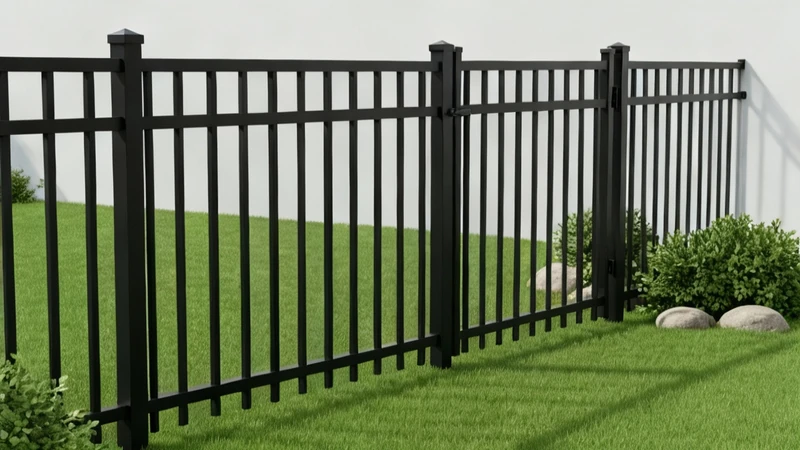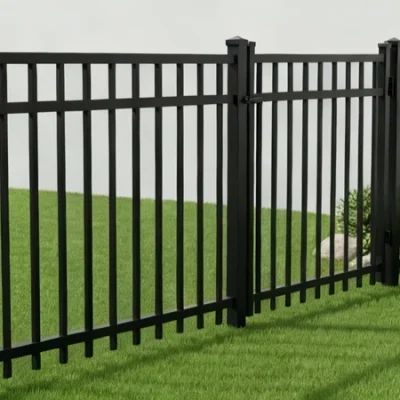Do Black Aluminum Fences Fade? What to Know Before You Buy

Introduction — straight talk
If you’re thinking about a black aluminum fence, one of the first practical questions is: will it fade? It’s fair — color matters. At Rutao we get that homeowners want a fence that still looks sharp five or ten years down the road. Below I’ll walk through what actually causes fading, what finishes stand up best, and simple habits that make a big difference.
Why people choose black aluminum
The look — why black works
Black gives clean lines and a modern frame to a yard.
It plays well with plants, wood, stone, and light-colored houses.
In short: black is versatile — it hides fasteners and complements most styles.
The practical side
Aluminum won’t rust like iron, and it’s light to handle during installation.
When it’s correctly finished, upkeep is straightforward: an occasional wash and you’re done.

Will a black aluminum fence actually fade?
The short answer
Yes — technically all outdoor finishes age. But if you buy a fence with a proper finish and treat it reasonably well, noticeable fading is slow. For many homeowners, the change is negligible for a decade or more.
The things that speed up fading
Sunlight (UV): Long-term sun exposure breaks down pigments.
Cheap coatings: Thin or poorly formulated finishes lose color faster.
Salt and pollution: Coastal and industrial areas can dull the surface.
Neglect: Built-up grime and chemicals accelerate wear.

What actually protects the black color — coatings explained
Powder coating — simple and strong
Powder coating is the most common finish for aluminum fences. It’s applied dry and cured in an oven, creating a bonded, hard surface that resists chipping and flaking much better than ordinary paint.
Higher-end finishes you should know about
Super-durable polyester powders and PVDF-type coatings are formulated for long-term UV resistance.
Look for suppliers who can explain their finish (and back it up with a warranty). These finishes make the biggest difference in long-term color retention.

How to keep that black looking black — real, usable tips
Simple maintenance (do this)
Rinse your fence with a garden hose every few months.
Use mild soap and a soft cloth for stubborn dirt — no abrasive pads.
After heavy storms or long dry spells, give it a quick rinse.
Small habits that help a lot
Don’t aim sprinklers directly at the panels (constant wet/dry cycles speed wear).
Rinse off salt spray if you’re near the sea.
Trim plants so they don’t stay wet against the metal.
When to touch up versus when to replace
Touch up if you have small scratches or isolated dull spots — a professional touch-up will restore appearance.
Consider recoating if large areas show chalking, uneven color, or peeling.
Replace only when structural damage makes repair impractical.
(Quick rule of thumb: superficial color issues ≠ structural failure. You rarely need to scrap a fence just for some fading.)

What to ask the manufacturer or supplier (a checklist)
What finish do you use? Ask specifically for powder type or PVDF.
Warranty length and coverage for the coating (10–20 years is common for better systems).
Do you do pretreatment? Proper cleaning and conversion coatings before powder are important.
Are panels tested for UV and salt exposure? If you’re local to a coast, that matters.
Material grade: For coastal installs, marine-grade aluminum is preferable.
If a supplier struggles to answer these clearly, it’s a red flag. Ask Rutao — we’ll explain the finish and the test methods we use.
Climate notes — where fading matters most
Sunny inland climates: UV exposure is the main factor. Pick UV-stable finishes.
Coastal climates: Salt spray + humidity call for marine-grade materials and more frequent rinses.
Polluted/industrial areas: Chemical deposits can accelerate surface breakdown — plan for more frequent cleaning.

Practical buying advice (my direct recommendations)
Prioritize finish quality over a small upfront savings. A slightly higher cost for a better coating saves money and headaches later.
Ask for photos of installed fences in similar climates. Pictures tell you more than promises.
Get the warranty in writing and understand what it covers — color loss, peeling, chalking? What are the exclusions?
Key takeaways (quick)
A black aluminum fence can keep a rich, dark look for many years if it has a good finish.
The biggest differences are the coating quality and the environment where the fence lives.
Simple maintenance (wash, rinse, avoid constant wetting) extends color life significantly.
Ask your supplier (or Rutao) clear questions about finish type, pretreatment, and warranty before you buy.
Final thoughts — a short, honest note
I’ll be blunt: color is a combination of chemistry and care. You can’t stop time, but you can stack the odds in your favor. Choose a supplier who knows coatings and is transparent about testing and warranties. If you want, Rutao can walk through finish options for your project and recommend the best choice for your climate and style.
Want a recommendation for your property? Tell us your climate and where the fence will live (front yard, pool, seaside), and we’ll point you toward the most practical finish and maintenance plan.
